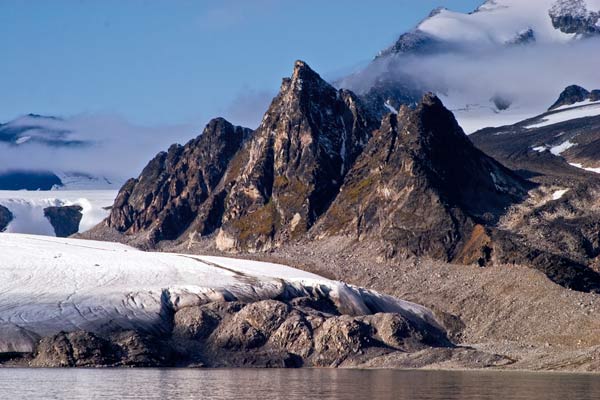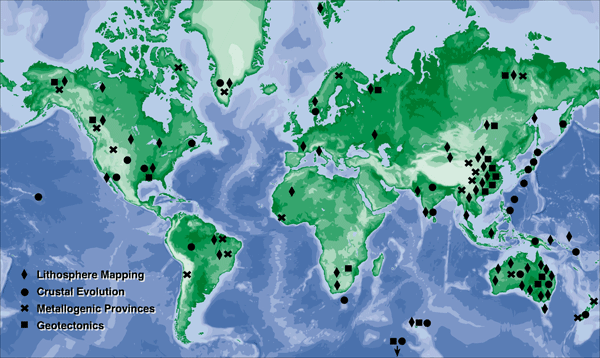GEMOC's research program
The research aims
- to understand from the “bottom-up” the processes that control the generation and modification of the crust-mantle system and to define the tectonic and geochemical processes that have created different crustal and mantle domains through time
- to understand how Earth’s core-mantle system controls crustal tectonics, and the assembly and destruction of continents through time
- to map the spatial and temporal distribution of elements, rock types and physical and chemical conditions within this system
- to constrain the processes responsible for the evolution of the Earth’s chemical reservoirs
- to define the systematics of element redistribution in the mantle and crust during the critical liquid-crystal and vapour-liquid separation events
- to quantify the transport of crustal material into the deep Earth, and its ultimate contribution to mantle plumes and the subcontinental lithosphere
- to advance the modelling of the crust and lithospheric mantle from geophysical datasets, through integration of geophysical, petrological and geochemical information
- to produce and interpret maps of lithosphere thickness and lithospheric mantle type at the present day and for selected time (and location) slices through Earth's geological evolution
- to produce and interpret chemical tomography sections of lithospheric mantle in time and space where global datasets can be constructed
- to provide a new framework for area selection for a wide spectrum of economic deposits, by linking these models and processes to the formation of metallogenic provinces
- to develop collaborative links with international institutions and researchers relevant to GEMOC's goals
- to define the timing of events and processes in the crust and mantle to understand crust-mantle linkages
Scientific context
Thermal energy transmitted through the mantle provides the energy to drive lithosphere processes. Mantle-derived fluids and the tectonic environment control element transfer across the crust-mantle boundary and control commodity distribution in the accessible crust. The nature of mantle heat transmission reveals information on fundamental deep Earth processes from the core-mantle boundary to the surface. The Earth’s lithosphere can be mapped for rock types and their relationships using fragments of deep materials such as mantle rocks and diamonds, and the compositions of mantle-derived magmas. Timescales can be unravelled from billions of years to tens of years.
What drives the heat engine that powers the Earth’s magnetic field and drives mantle convection? We do not clearly understand this, because we do not know the contents of heat-producing radioactive elements (K, U, Th) in the lower mantle and the core, and how these may have changed with Earth’s evolution. Experimental studies of Earth materials at extreme conditions will provide new constraints for modelling of the mantle and the evolution of the early Earth.
The focus of GEMOC’s research programs is the driving role of the mantle in Earth processes and its control of element concentration and distribution in the accessible crust. This bottom-up approach involves:
- Understanding Earth’s internal dynamics and the generation of the present chemical and physical structure of our planet through time
- Understanding the location of different types of metallogenic provinces by defining the links between:
- mantle evolution, type and processes
- crustal generation
- large-scale tectonics
- heat, fluid and element transport
- mantle evolution, type and processes
- Integration of information across disciplines, especially petrology, geochemistry, geodynamics, geophysics and tectonics
Research Program
The Research Highlights section gives an overview of major progress in 2004.
The Research Program for 2005 follows the topics of the funded projects listed in Appendix 5. Summaries of funded basic research projects are listed below and some of the collaborative industry research projects are summarised in the section on Industry Interaction.
The research program for the first six years focused on four strands: the current Research Program is pushing into new conceptual and technology frontiers, building on our intellectual capital from the first phase of GEMOC. Additional details on the Research Programs are given at www.es.mq.edu.au/GEMOC/

View from the MS-Polarsyssel on the way into Bockfjiord, NW Spitsbergen.
Mantle dynamics and composition
will form the framework for advancing our knowledge of Earth’s geochemical and physical evolution. The thermal output driving Earth’s “engine” has declined exponentially through time, and the distribution of heat sources must have changed with the geochemical evolution of Earth. How has this secular cooling of Earth affected the internal driving forces, and what does this imply about changes in Earth dynamics through time? When did subduction processes begin? Novel approaches using redox-sensitive metal-isotope systems will be used to examine changes in the mantle’s oxidation state, potentially linked to the initiation of subduction. Modelling of Earth’s thermal history, incorporating information about the present and past distribution of heat-producing elements and processes will be used to test conceptual models for Earth’s internal dynamics through time. High-pressure experimental approaches will advance our understanding of deep Earth structure and properties.
Lithosphere Mapping provides the fundamental data for defining lithospheric mantle domains in terms of composition, structure and thermal state. Lithosphere profiles built up by this information are interpreted in the context of geophysical datsets (especially seismic tomography) to extrapolate laterally. Relating lithospheric domains to refined models of tectonic evolution will help to define the large-scale evolution of mantle processes through time, and their influence on the development of the crust and metallogenic provinces. The nature of mantle fluids and the mantle residence and abundances of siderophile, chalcophile and noble elements, sulfur, carbon, oxygen and nitrogen and timescales of magmatic processes are keys to understanding the transfer of mineralising elements into the crust.
Geodynamics
uses stratigraphic, tectonic, and geophysical data to interpret the history and causes of continental assembly and disruption, with a special focus on Australia, East Asia and major cratons (Siberia, Africa, Canada, South America, India). It provides the fundamental framework to link the research on crustal and mantle processes with the localisation and development of metallogenic provinces.
Crustal Generation Processes
seeks to understand the large-scale processes that have created and modified continental crust, how these processes may have changed through time, and how crustal processes influence the concentration and localisation of economically important elements. The role of crust-mantle interaction in granite genesis, coupled crust-mantle formation and its influence on tectonism, and transport of elements across the crust-mantle boundary link to the Lithosphere Mapping and Metallogenesis strands.
Metallogenic Provinces
seeks to define the mantle and crustal reservoirs of economically important elements, the mechanisms by which elements can be extracted from the mantle and transported into the crust, and the mechanisms of fluid transfer in the crust and mantle. The emphasis is on understanding processes of regional scale, and relating these processes to the tectonic framework and the processes of mantle and crustal generation.
Research projects feeding major programs
Lithosphere Mapping
Lithosphere mapping: Geochemical structure and evolution of continental lithosphere and interpretation of geophysical data Research Highlights
U-series applications to timescales of lithosphere processes Research Highlights
Mantle terranes and cratonic roots: Canada, USA, southern Africa, Siberia, eastern China, Australia, Brazil, India, Spitsbergen Research Highlights
Gravity modelling of lithosphere terranes (regional elastic thickness)
Evolution of oceanic lithosphere: Kerguelen Plateau, Hawaii, Crozet Islands Research Highlights
Diamonds: origin and clues to deep mantle and lithosphere evolution and structure; Canada, Siberia, South Africa
Seismic imaging of Moho structure and integration with petrological data: Indian Ocean, Kerguelen Plateau
Basalts as lithosphere/asthenosphere probes
Thermal framework of the lithosphere: paleogeotherms, heat production, conductivity, thermal evolution
Experimental studies of mantle minerals: high pressure partition coefficients; role of accessory minerals in controlling mantle fluid compositions
Lithosphere extension processes and consequences in East Asia: Taiwan and eastern China regions Research Highlights
Constraints on the timing of depletion and fluid movements in lithospheric mantle of different ages, using a range of isotopic and trace-element methods, including Re-Os in mantle sulfides Research Highlights
The nature of lithospheric mantle in arc regions (Japan, Kamchatka, Philippines, Solomon Islands)
Tracking mantle plumes through time
Metal isotopes as tracers of lithosphere processes and Earth evolution
Crustal Evolution
Role of oceanic plateaus in oceanic and continental crustal formation: Kerguelen
Crustal evolution and metallogenesis, southeastern China
Evolution of continental crust: central Queensland; San Francisco Volcanic Field, Arizona; Peninsular Ranges batholith of Baja California, Mexico; western Norway Research Highlights
Origin of granites and crustal genesis at continental margins: eastern Australia, southeastern China Research Highlights
Metamorphic reactions and mineral growth; microstructural processes in metamorphic rocks
Oceanic crust evolution Research Highlights
Tracers of magmatic processes; trace elements in accessory minerals
Integrated U-Pb, Hf-isotope and trace-element in situ analysis of detrital zircons to characterise the magmatic history of major crustal terrains (“Event Signatures”): applications of TerraneChronTM, South America, Canada, South Africa, Australia, India, Norway Research Highlights
Timescales of magmatic and erosional processes (U-series applications) Research Highlights
Hf-isotopic signatures of zircons (in situ LAM-ICPMS) as tracers of crust-mantle interaction in granites Research Highlights
Metallogenesis
Risk management in exploration Research Highlights
U-series applications to timescales of fluid movement
Metal isotope applications to ore genesis
Geochemistry of mantle sulfides Research Highlights
Chromite chemistry in mantle-derived magmas and residues
Resistate minerals and mineral exploration Research Highlights
Area selection and evaluation for diamond exploration
Lithosphere domains through time and location of ore deposits
Crust-mantle interaction, granites and metallogenesis through time Research Highlights
Sulfide and PGE budget of the mantle Research Highlights
Re-Os dating of mantle sulfides in situ and timing of mantle processes Research Highlights
Highly siderophile element (including platinum group element) concentrations in sulfides (LAM-ICPMS) Research Highlights
Zircon composition in mineral exploration Research Highlights
Groundwater geochemistry and aquifer lithology
Stable-isotope ratios of some important commodity elements (eg Cu, Fe, Zn, Mo) in a range of ore minerals and deposit types
Trace elements in diamonds - possible genetic indicators?
Geotectonics
Influence of mantle processes on crustal geology and topography: regional geotectonic analysis: Slave Craton (Canada), Siberia, eastern China, Australia, Kaapvaal Craton, India Research Highlights
Neoproterozoic earth history of Australia: Tectonics, isotope-, volcanic- and bio-stratigraphy
Tasman Fold Belt tectonism and regional volcanology
Paleomagnetic studies of the northern New England Orogen
Antarctic seismic studies Research Highlights
Deep crustal processes (New Zealand)
Plate margin processes (Papua New Guinea)
Geodynamic modelling of large-scale processes using constraints from 4-D Lithosphere Mapping results
Evolution of lithospheric composition and Earth geodynamics through time
WHERE IN THE WORLD IS GEMOC


 GEMOC ARC National Key Centre
GEMOC ARC National Key Centre